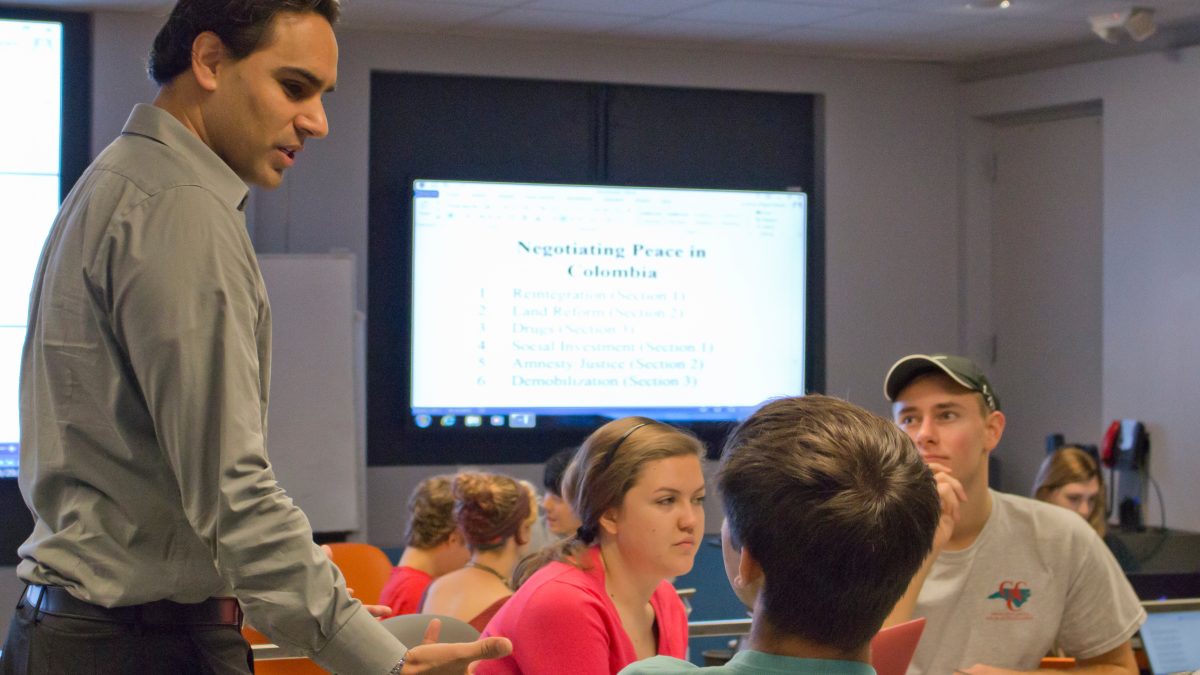Greenlaw 101, lecture hall for the 21st century
Greenlaw 101, which can hold more than 100 students, is one of the first of the interactive classrooms to be finished.

The recently remodeled Greenlaw 101 lecture hall has several cool features: a bright orange accent wall, rolling swivel chairs with adjustable desks and cupholders and a catwalk down the center of the room. The room’s eight big video screens plus a nine-panel screen in the front connect to the Internet or to an individual’s laptop or notebook.
“It does look a little bit like a sports bar, now that you mention it,” observed Eric Muller, former director of the Center for Faculty Excellence, one of the partners in the renovation, at the Dec. 15 demonstration of the room.
Despite looking like a great place to catch the game, Greenlaw 101 is still a lecture hall. But it’s a 21st century interactive lecture hall, the first of its kind on campus big enough for 100 students or more.
The project, piloted in the fall 2015 semester, comes in response to a 2012 faculty survey on classrooms and resulting recommendations made to the Classroom Policy Steering Committee. “Develop a renovation plan for an interactive lecture hall” was Recommendation No. 8 from the Classroom Innovation Subcommittee.
With research showing that students learn more and better when taught in an interactive way, a growing number of faculty are incorporating interactive techniques in their teaching.
But the techniques can be hard to implement in a traditional classroom, so the University began five years ago to renovate classrooms and use different furniture to make collaborating and group discussion easier. Studio classrooms, for example, group students around tables. Seats that roll or that swivel 360 degrees make it easier to make eye contact with the instructor and each other.
“We have about 220 general purpose classrooms on this part of campus and only about 16 of them are designed for interaction,” said Carol Tresolini, vice provost for academic initiatives. None of those redesigned classes could hold 100 students.
Because classroom renovations belong to “everybody and nobody,” she said, the Greenlaw 101 project required the collaboration of the academic side as well as facilities services and ITS.
To transform this large lecture hall, renovators removed its stadium-style seating and steps, replacing them with a new, gently sloped concrete floor and six learning zones divided by railings and a center aisle (which also functions as a wheelchair ramp).
They furnished the room with Node chairs, a swivel chair that rolls and also has a base for storing books and backpacks so students’ stuff moves with them, making transitions quicker and easier. The furniture was provided through an active learning research grant from Steelcase.
The room also has Mirroring360 software, which enables instructors (or students) to share their device screens on the screens wirelessly. “With the tech in here, there was never a question of if I’d be able to do something but how,” said Devin Hubbard, biomedical engineering lecturer. “It overwhelmed me the amount of options there were to interact with students.”
With the technology and design of Greenlaw 101, professors can make any subject highly interactive. Thirteen faculty members from a wide range of subjects used the room, each differently.
“There are some stark commonalities: group work, getting out in the classroom, generally technology. But it fits all of our disciplines in different ways,” said history professor Kathleen DuVal.
Tricia Sullivan, associate professor of public policy, did a simulation of a national security situation in her peace, war and defense class. Divided into country teams, the students were constantly in motion – negotiating treaties, planning strategies, getting information.
“That couldn’t have happened in the lecture hall,” Sullivan said. “The students must be able to move around.”
Faculty members noticed real changes in the students and themselves, they said. The flexibility of the classroom helped them get to know their students better and faster. Being able to approach any student via the center or side aisles even made it easier to hand out papers, they said.
Survey research about the Greenlaw 101 project isn’t in yet, but anecdotally the instructors agreed that attendance was higher in their classes and that their students were more engaged and more willing to talk in class. The students also got to know one another better and didn’t seem to mind participating in group projects as much.
“Life is one great big uncomfortable group project, so we all have to learn how to do that,” said Lois Boynton, associate professor in the School of Media and Journalism. “This is a safe place to have that.”
Group project discussions were almost impossible in a traditional lecture hall, said chemistry lecturer Thomas Freeman. Group members sat in the same row of fixed seats and the students on the ends were left out. By contrast, in Greenlaw 101 “all the students know each other and communicate in a way that’s more natural,” he said.
“I love this place,” Boynton said.
So do all 13 faculty members who used it, since all have asked to teach in Greenlaw 101 again. “The flexibility of the classroom allows for the kind of teaching I want to do,” Hubbard said. “I can’t wait to work in here again next year. I’m already retooling all of my stuff.”




